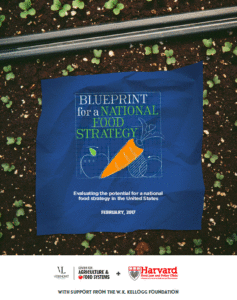Blueprint for a National Food Strategy
Food policy clinics at the Harvard and Vermont law schools have issued a new report—interactive no less.

The report argues that
our food system often works at cross-purposes, providing abundance while creating inefficiencies, and imposing unnecessary burdens on our economy, environment, and overall health. Many federal policies, laws, and regulations guide and structure our food system. However, these laws are fragmented and sometimes inconsistent, hindering food system improvements. To promote a healthy, economically viable, equitable, and resilient food system, the United States needs a coordinated federal approach to food and agricultural law and policy – that is, a national food strategy.
The strategy needs to focus on :
- Coordination: Create a lead office and an interagency working group, and engage local governments.
- Participation: Create an advisory council, develop methods for participation, feedback, and response.
- Transparency and accountability: Create a strategy document, publish progress reports.
- Durability: Ensure updating, implement procedures.
Yes, it’s wonky, but if you download the pdf you get to weigh in on all this.




